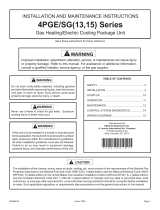3
II. INTRODUCTION
This booklet contains the installation and operating instructions for your combination gas
heating/electric cooling unit. There are some precautions that should be taken to derive
maximum satisfaction from it. Improper installation can result in unsatisfactory operation
or dangerous conditions.
Read this booklet and any instructions packaged with separate equipment required to
make up the system prior to installation. Give this booklet to the owner and explain its
provisions. The owner should retain this booklet for future reference.
III. CHECKING PRODUCT RECEIVED
Upon receiving the unit, inspect it for any damage from shipment. Claims for damage,
either shipping or concealed, should be filed immediately with the shipping company.
IMPORTANT: Check the unit model number, heating size, electrical characteristics, and
accessories to determine if they are correct.
IV. SPECIFICATIONS
A. GENERAL
The Combination Gas Heating/Electric Cooling Rooftop is available in 80,000, 100,000,
120,000 and 135,000 BTU/Hr. heating inputs and cooling capacities of 3, 3
1
⁄2, 4, and 5
nominal tons of cooling. Units are convertible from bottom supply and return to side sup-
ply and return by relocation of supply and return air access panels. See cover installa-
tion detail.
The units are weatherized for mounting outside of the building.
The information on the rating plate is in compliance with the FTC and DOE rating for sin-
gle phase units. The following information is for three phase units which are not covered
under the DOE certification program.
1. The energy consumption of the ignition system used with this unit is 9 watts.
2. The efficiency rating of this unit is a product thermal efficiency rating determined
under continuous operating conditions independent of any installed system.
B. MAJOR COMPONENTS
The unit includes a hermetically-sealed refrigerating system (consisting of a scroll com-
pressor, condenser coil, evaporator coil with capillary tube assembly), a circulation air
blower, a condenser fan, a heat exchanger assembly, gas burner and control assembly,
combustion air motor and fan, and all necessary internal electrical wiring. The cooling
system of these units is factory-evacuated, charged and performance tested. Refrigerant
amount and type are indicated on rating plate.
V. SAFETY INFORMATION
!
WARNING
THE MANUFACTURER’S WARRAN-
TY DOES NOT COVER ANY DAM-
AGE OR DEFECT TO THE AIR CON-
DITIONER CAUSED BY THE
ATTACHMENT OR USE OF ANY
COMPONENTS, ACCESSORIES OR
DEVICES (OTHER THAN THOSE
AUTHORIZED BY THE MANUFAC-
TURER) INTO, ONTO OR IN CON-
JUNCTION WITH THE AIR CONDI-
TIONER. YOU SHOULD BE AWARE
THAT THE USE OF UNAUTHO-
RIZED COMPONENTS, ACCES-
SORIES OR DEVICES MAY
ADVERSELY AFFECT THE OPERA-
TION OF THE AIR CONDITIONER
AND MAY ALSO ENDANGER LIFE
AND PROPERTY. THE MANUFAC-
TURER DISCLAIMS ANY RESPON-
SIBILITY FOR SUCH LOSS OR
INJURY RESULTING FROM THE
USE OF SUCH UNAUTHORIZED
COMPONENTS, ACCESSORIES OR
DEVICES.
!
WARNING
UNITS ARE NOT DESIGN CERTIFIED TO BE INSTALLED INSIDE THE STRUC-
TURE. DOING SO CAN CAUSE INADEQUATE UNIT PERFORMANCE AS WELL
AS PROPERTY DAMAGE AND CARBON MONOXIDE POISONING RESULTING
IN PERSONAL INJURY OR DEATH.
!
WARNING
USE ONLY WITH TYPE OF GAS APPROVED FOR THIS UNIT. REFER TO THE
UNIT RATING PLATE.
Recognize this symbol as an indi-
ca tion of Important Sa fety
Information!
!
!
WARNING
INSTALL THIS UNIT ONLY IN A
LOCATION AND POSITION AS
SPECIFIED IN THE LOCATION
REQUIREMENTS AND CONSIDERA-
TIONS SECTION OF THESE
INSTRUCTIONS. PROVIDE ADE-
QUATE COMBUSTION AND VENTI-
LATION AIR TO THE UNIT SPACE
AS SPECIFIED IN THE VENTING
SECTION OF THESE INSTRUC-
TIONS.
!
WARNING
PROVIDE ADEQUATE COMBUS-
TION AND VENTILATION AIR TO
THE UNIT SPACE AS SPECIFIED IN
THE COMBUSTION AND VENTILA-
TION AIR SECTION OF THESE
INSTRUCTIONS.
!
WARNING
COMBUSTION PRODUCTS MUST
BE DISCHARGED OUTDOORS.
CONNECT THIS UNIT TO AN
APPROVED VENT SYSTEM ONLY,
AS SPECIFIED IN VENT PIPE
INSTALLATION SECTION OF
THESE INSTRUCTIONS.




















